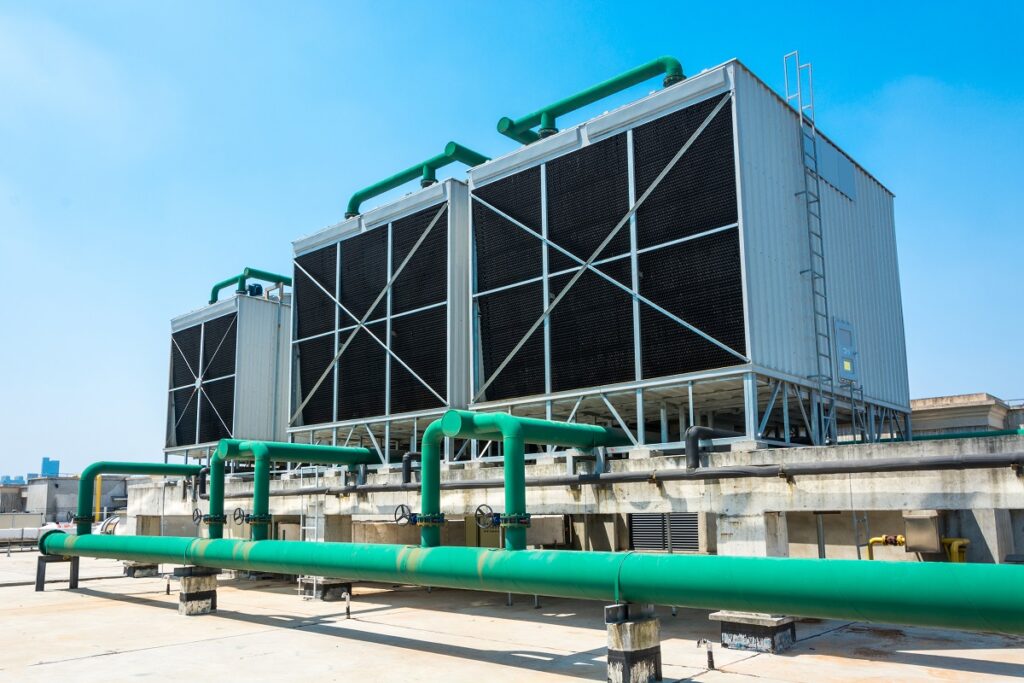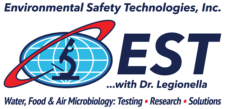
It is the time of year where, in many parts of the country, commercial cooling towers that run seasonally are needed to come back online as outdoor temperatures increase. Therefore, it is important to follow cooling tower start-up steps and best practices for the mechanical systems. It is equally important to notify the company or individual performing water treatment services for the tower in advance of the start-up of the cooling towers.
The goal of effective water treatment is to provide clean heat transfer, piping, and other water contact surfaces. Prior to seasonal cooling tower start-up, surfaces are exposed to the elements of air and water, which can impact four main areas:
- Scaling
- Scale and deposition of organic and inorganic materials which impact heat transfer and may ultimately lead to reduced or total blockage of water flow.
- Corrosion
- Corrosion is the leading reason cooling towers are replaced, due to potential impact of the tower’s ability to remove heat effectively and allow drift.
- Biofouling
- Biofilms, particularly on the condenser tubes, impact short-term efficient heat transfer and can contribute to microbial-induced corrosion.
- Legionella growth
- As temperatures rise, Legionella proliferation in the cooling tower can lead to an increased risk of exposure and contraction Legionnaires’ Disease.
Therefore, it is imperative that a preventive course of action begins before initial start-up of cooling towers. As microbiology specialists, EST can provide testing and expertise to address the Legionella growth, bio-fouling, and microbial-induced corrosion threats.
During cooling tower start-up, preliminary inspections of critical heat transfer surfaces and other susceptible areas should be made. In some states, this inspection is a requirement. If significant issues are found prior to start-up, this can be addressed immediately instead of attempting repairs when the tower is running. It is also important to make sure that the tower and the condenser piping is clean before start-up. Drift eliminators should also be repaired and/or replaced as necessary to minimize drift. Failure to clean before start-up can lead to high bacteria counts, including the presence of Legionella in excessive numbers, and clogged system pipes.
Recommendations for Cooling Tower Start-Up Steps and Processes
We recommend that the system be cleaned and sanitized in accordance with ASHRAE Guideline 12-2020, which states:
- Cleaning all debris such as leaves, dirt, etc. from the cooling tower.
- Filling the system with water and operating the condenser pumps but not the fans, and then follow one of two protocols:
- Maintain the maximum recommended biocide using the biocide used prior the shutdown for a sufficient period (as recommended by the biocide manufacturer) or
- Treat the system with sodium hypochlorite to a level of 4 to 5 ppm of “free” chlorine at a pH of 7.0 to 7.6. Hold this residual for a period of six hours.
Once biocidal treatment has been successfully completed, wait for one hour after completion to obtain a Legionella sample and send it to a CDC ELITE Lab. EST is a CDC ELITE lab that provides Legionella testing services, including next-day Legionella testing by Viable Legionella PCR methodology. To learn more about our services, click the link below.
Prior to the system’s return to service, EST also advises to collect baseline levels of Microbial Induced Corrosion (MIC) bacteria as an additional measure of biocide effectiveness. Click the link below to learn more about MIC bacteria.
After system cleanliness has been confirmed, the fan can then be energized, and the system can be returned to service. The standard water treatment program may then be followed. Demand is often low for cooling towers in the spring, they may operate in pump-only mode, and have little need for freshwater makeup. Since some water treatment programs are demand-based, your water treatment program may not call for the addition of chemicals. It is important then to ensure that the proper level of biocides and scale/corrosion inhibitors are resident in the system water at start-up, with a few weeks of low demand to follow. EST recommends that a Legionella sample be taken two to three weeks after start-up and then routinely (monthly or quarterly) during the operating season or in accordance with the Water Management Plan (WMP) to ensure that the on-going biocide program is effective.
In addition to regular Legionella testing, it is advised to also perform Heterotrophic Plate Count (HPC), or Dip Slides on a weekly basis. While this is a legal requirement in some states, it should be noted that there is no correlation between HPC counts and the presence of Legionella bacteria in cooling system waters. However, HPC counts, and dip slides are useful in determining the presence of biological growth which may impact system performance.
Start the spring with a clean cooling tower to reduce energy consumption, corrosion potential, biological fouling, and the risk of disease.
Start Clean, Start Safe!
Let us know if you have questions about cooling tower start-up, Legionella testing or if you need help with a Legionella WMP.

Dr. Richard Miller
Environmental Safety Technologies, Inc (EST) was founded by Dr. Richard Miller and co-founder Shauna Weis. For over 25 years EST has provided clients with top-of-the-line Legionella testing services on building water systems, for validating the control of Legionella proliferation in the building water in accordance with ANSI/ASHRAE Legionella Standard 188-2021 and the CDC Toolkit: Developing a Water Management Program to Reduce Legionella Growth and Spread in Buildings (2021).
In addition to Dr. Miller’s 25 years with EST, he has over 40 years of experience in working with Legionella. It all started with his research program at the University of Louisville School of Medicine in the fall of 1977, when the Legionnaires’ disease bacterium had only been recently isolated by CDC several months earlier, and it didn’t even have a name yet. Once it was reported that the transmission of Legionnaires’ disease was from environmental aquatic habitats (replicating within free-living amoebae), Dr. Miller received personal training in Legionella environmental culture at the CDC from Legionella pioneers Dr. Jim Feeley and George Gorman. Over those 40 years, Dr. Miller acquired experience via: 1) laboratory research, training graduate students and unraveling the physiology, metabolism, and pathogenesis of this bacterium, 2) Legionella testing of cooling towers, potable water, whirlpool spas and decorative fountains for growing list of clients, and finally, 3) teaching Legionnaires’ disease (and more than 30 other bacterial and fungal infectious diseases lecture topics) to the medical students at the University of Louisville. With this experience, there is not much about Legionella or Legionnaires’ disease (or medical microbiology more broadly) that Dr. Richard Miller does not know something about.

